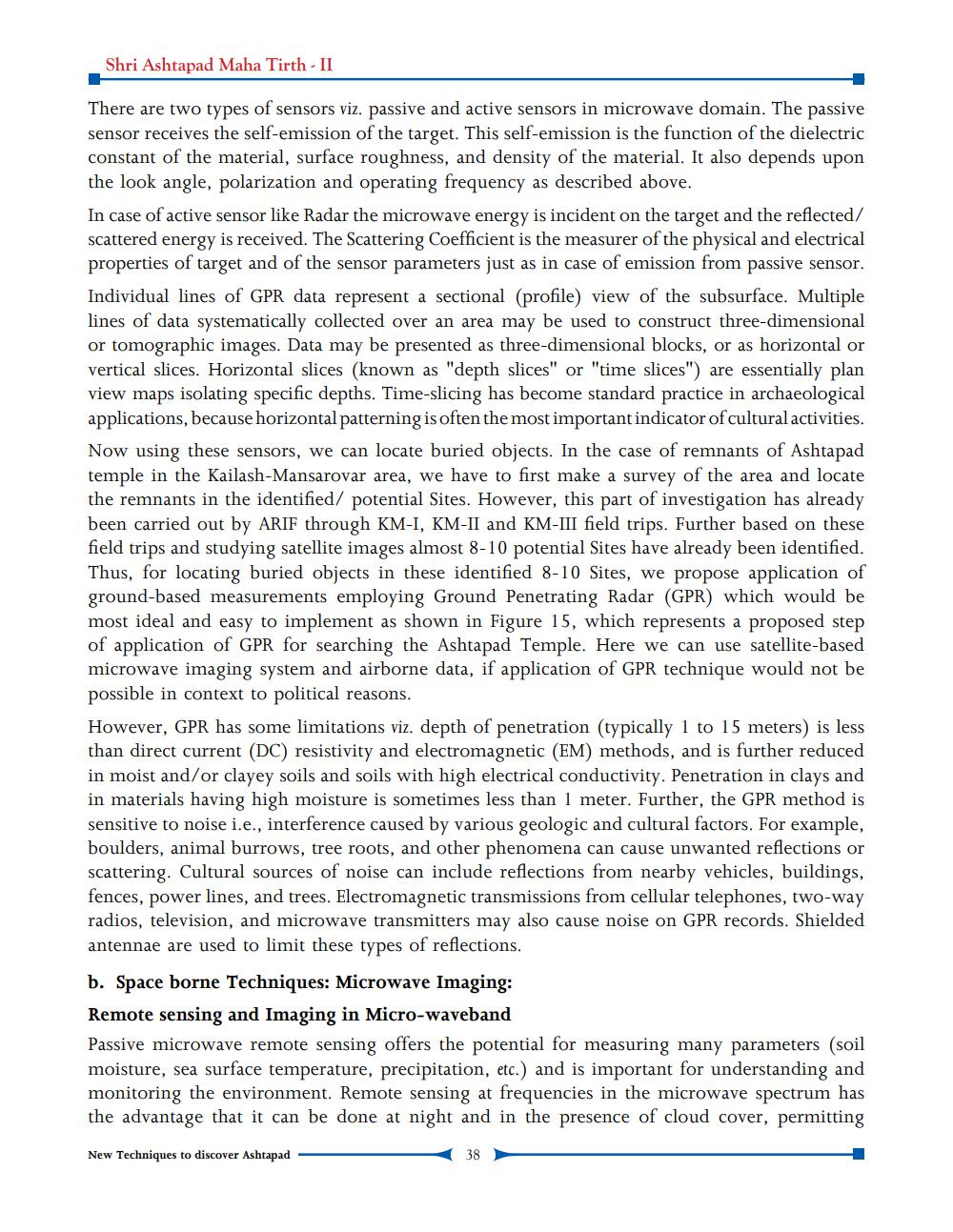________________
Shri Ashtapad Maha Tirth - II
There are two types of sensors viz. passive and active sensors in microwave domain. The passive sensor receives the self-emission of the target. This self-emission is the function of the dielectric constant of the material, surface roughness, and density of the material. It also depends upon the look angle, polarization and operating frequency as described above. In case of active sensor like Radar the microwave energy is incident on the target and the reflected/ scattered energy is received. The Scattering Coefficient is the measurer of the physical and electrical properties of target and of the sensor parameters just as in case of emission from passive sensor. Individual lines of GPR data represent a sectional (profile) view of the subsurface. Multiple lines of data systematically collected over an area may be used to construct three-dimensional or tomographic images. Data may be presented as three-dimensional blocks, or as horizontal or vertical slices. Horizontal slices (known as "depth slices" or "time slices") are essentially plan view maps isolating specific depths. Time-slicing has become standard practice in archaeological applications, because horizontal patterning is often the most important indicator of cultural activities. Now using these sensors, we can locate buried objects. In the case of remnants of Ashtapad temple in the Kailash-Mansarovar area, we have to first make a survey of the area and locate the remnants in the identified/ potential Sites. However, this part of investigation has already been carried out by ARIF through KM-I, KM-II and KM-III field trips. Further based on these field trips and studying satellite images almost 8-10 potential Sites have already been identified. Thus, for locating buried objects in these identified 8-10 Sites, we propose application of ground-based measurements employing Ground Penetrating Radar (GPR) which would be most ideal and easy to implement as shown in Figure 15, which represents a proposed step of application of GPR for searching the Ashtapad Temple. Here we can use satellite-based microwave imaging system and airborne data, if application of GPR technique would not be possible in context to political reasons. However, GPR has some limitations viz. depth of penetration (typically 1 to 15 meters) is less than direct current (DC) resistivity and electromagnetic (EM) methods, and is further reduced in moist and/or clayey soils and soils with high electrical conductivity. Penetration in clays and in materials having high moisture is sometimes less than 1 meter. Further, the GPR method is sensitive to noise i.e., interference caused by various geologic and cultural factors. For example, boulders, animal burrows, tree roots, and other phenomena can cause unwanted reflections or scattering. Cultural sources of noise can include reflections from nearby vehicles, buildings, fences, power lines, and trees. Electromagnetic transmissions from cellular telephones, two-way radios, television, and microwave transmitters may also cause noise on GPR records. Shielded antennae are used to limit these types of reflections. b. Space borne Techniques: Microwave Imaging: Remote sensing and Imaging in Micro-waveband Passive microwave remote sensing offers the potential for measuring many parameters (soil moisture, sea surface temperature, precipitation, etc.) and is important for understanding and monitoring the environment. Remote sensing at frequencies in the microwave spectrum has the advantage that it can be done at night and in the presence of cloud cover, permitting
New Techniques to discover Ashtapad
(38




